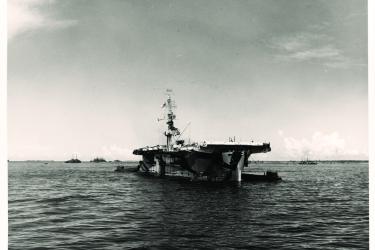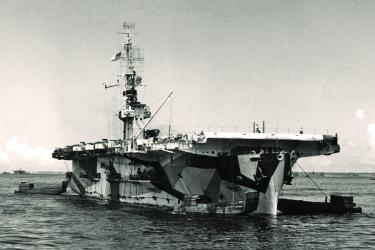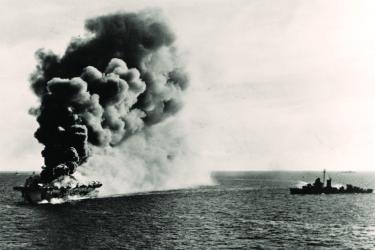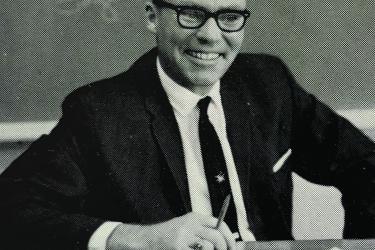A day for remembrance
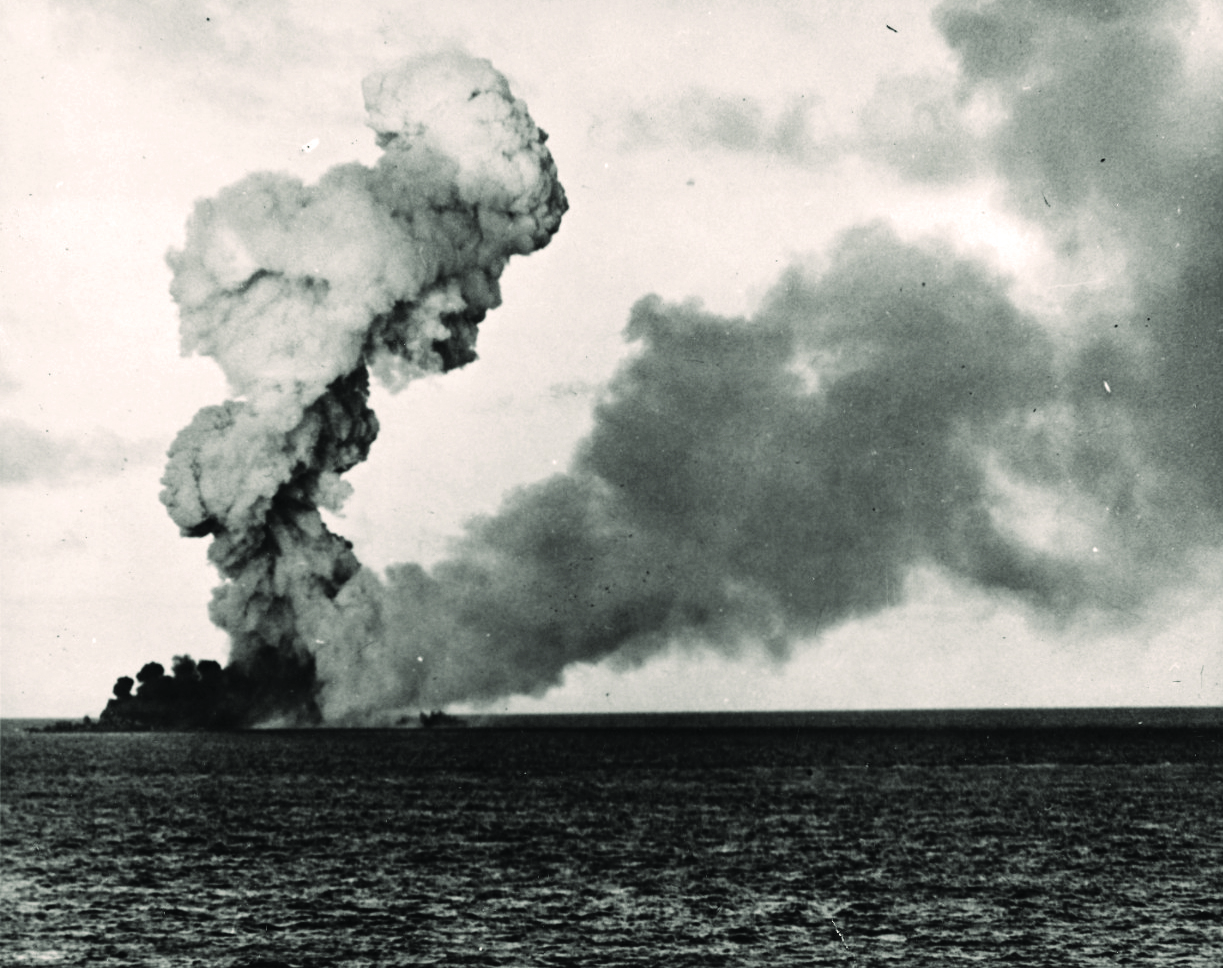
Courtesy of Naval History and Heritage Command US Navy escort carrier, The USS Ommaney Bay, after being attacked by kamikaze planes in the Sulu Sea, a portion of the western North Pacific Ocean, on Jan. 4, 1945.
Longtime Upton teacher survived sinking of USS Ommaney Bay
It was Jan. 4 of 1945, World War II still raging on, and the USS Ommaney Bay floated in the Sulu Sea. Seemingly out of nowhere, a Japanese suicide plane began its descent, straight toward the ship. With the blinding sun at its back, the plane was seen too late to stop it from plowing into the Ommaney Bay.
Chaos ensued with fires, explosions and ammunition going off, before the captain eventually called to abandon ship. Robert Rinegar, radioman and petty officer third class, was serving his country in the throes of World War II and was aboard the U.S. Navy escort carrier when it was attacked by kamikaze planes and sunk in the Sulu Sea, a portion of the western North Pacific Ocean.
Not many people know about Rinegar’s time in the Navy, but the beloved Upton High School business teacher (1950 to 1987), experienced a lot during his time in World War II, including the sinking of the USS Ommaney Bay.
The USS Ommaney Bay was involved in the Lingayen Gulf Landings amphibious operation, with the intent to invade Luzon in the Philippines on Jan. 9, 1945, according to an article from the Naval History and Heritage Command.
“The plan called for 68,000 U.S. troops of the Sixth Army to be put ashore on the first day at the southern end of Lingayen Gulf (with over 200,000 troops to be ashore within several days) all under the overall command of General of the Army Douglas MacArthur,” the article states.
The plan consisted of multiple task forces composed of groups of ships. The USS Ommaney Bay was one of the accompanying escort carriers for a group of ships under the command of Vice Admiral Jesse B. Oldendorf. They departed Leyte Gulf in the Philippines on December 2, 1944, on their route to Luzon.
The attack
“As the main part of Oldendorf’s force passed through Surigao Strait into the Sulu Sea, it divided into a van and rear group, each group centered around a nucleus of escort carriers …,” the article states.
The article adds that during the day of Jan. 3, 1945, the combat air patrol “thwarted a 120-plane effort by the Japanese.”
However, on Jan. 4, radar detected about 15 Japanese planes about 45 miles from the group led by Oldendorf.
After the planes divided into two different groups, with radar readings being affected by the nearby islands, one of the airplanes approached the USS Ommaney Bay — and because of the position of the sun, it wasn’t seen until it was too late to defend against it.
“The Frances (aircraft) hit the island superstructure, just missing the commanding officer and executive officer, but wiping out the signal bridge before crashing into the flight deck, releasing two bombs as it did. One bomb penetrated the flight deck, exploding among fully fueled aircraft in the forward hanging bay, while the second bomb penetrated to the second deck before exploding, rupturing the fire main. Wreckage from the plane hit a TBM Avenger on the flight deck, starting a fire that engulfed the aft end of the flight deck. The intense flames and exploding ammunition made it difficult for destroyers to approach and assist, though the Bell (DD-587) was damaged when she collided with Ommaney Bay while attempting to fight the fire,” the article reports.
According to Michael Rinegar, Robert’s son, his dad remembers the plane coming out of nowhere and going down the elevator shaft to the hangar deck below, where explosions and fires ensued, along with ammunition going off.
The crew began to lower the wounded into the water on stretchers. Eventually, the whole top was engulfed in flames, and they knew the fire would reach where the torpedoes were stored, which would set off a large explosion, according to the articles.
Capt. Howard L. Young, ordered the ship to be abandoned and shortly after he evacuated as the last man off, the torpedoes blew.
“At 1818 (military time), the torpedoes blew, and a massive explosion ripped Ommaney Bay apart, hitting nearby destroyers with debris and killing an unknown number of sailors in the water …” the article says.
The USS Ommaney Bay still did not sink, but orders were given to scuttle her with torpedoes from another ship. Ninety-three of Ommaney Bay’s crewmen died, and 65 were injured.
“Dad and his shipmate friend, Kimsey, donned their life jackets and jumped off the bow into the Sulu Sea, along with a small MA (Master of Arms — USN on board police) named Barney, who was not well liked,” Michael wrote about his dad’s experience after the attack on the Ommaney Bay, in a document he compiled for the News Letter Journal.
Michael continued in his writing, telling of how Rinegar and Kimsey were in the water for a while, and they had to help keep Barney afloat, whom they had knocked somewhat unconscious because he was dragging them down in his panic.
Most of the survivors then got picked up by the USS Columbia, including Rinegar, Kimsey and Barney, according to Michael.
While that’s not where the story ends for the Lingayen operation, World War II or Rinegar’s own Navy experience, it’s also not the only story to be told of Rinegar’s long life. His experience in the military, and specifically on that day, certainly impacted his life, according to Michael.
The soldier turned teacher
Rinegar’s story began on April 6, 1925, when he was born to Cameron Arthur and Arla Vickerman Rinegar in Pukwana, South Dakota. His family was a very musical one, according to Michael, and had their own dance band, Cam’s Imperials.
He enlisted in the Navy after graduating from high school in Pukwana, and according to a 2007 obituary, he participated in the Pacific Campaign of World War II.
Rinegar’s job aboard the ship entailed playing music for the ship, but he was also in charge of some of the communications for the ship.
“One of Dad’s jobs was sitting in a windowless room with a typewriter with capped keys, a light, and during combat only a red one, and a loudspeaker, a squawk box, as he called it, with a big luminous clock,” wrote Michael.
Rinegar would type reports on the status of the ship and hand them to a seaman standing outside the door, who would then carry it to the officer on the bridge.
“He would listen to the air group airmen currently aloft, speaking in code, and type that and send it to the bridge,” Michael wrote.
Rinegar attended Dakota Wesleyan University in Mitchell, South Dakota, after the war. There, he met MarJean Ollenburg, and the two were married in 1948.
After graduating from college in 1950, the couple, along with oldest daughter Patti, came to Newcastle, where Rinegar’s aunt lived and worked, Michael wrote.
Rinegar, who had a bachelor’s degree, majoring in history and minoring in religion, sought out a teaching job with Weston County School District No. 7. After completing work for a physical science course and testing out of the business courses in typing and shorthand at the University of Wyoming, he started as Upton High School’s new business teacher.
Michael wrote that his dad later included other business subjects in his teacher certificate, and he also received his master’s degree from Black Hills Teachers College in Spearfish, South Dakota (now Black Hills State University).
“Everyone thought Dad was the coolest teacher, the most well-liked, because … Dad played music while we typed in class,” Michael wrote.
Rinegar was also the drivers education teacher for Upton for many years. All four of Rinegar’s kids took driver’s education from him, Michael said, and even MarJean did.
Rinegar’s impact on his students went beyond just what he taught in the classroom. Morece Dillon, former student of Rinegar’s and a fellow teacher, said that he loved him as a teacher and coworker.
“He was someone you could always go to if you needed to talk to somebody. He was always encouraging,” Dillon said. “I’d lean on him for help if I had questions about something,” he added about his early years as a teacher looking up to Rinegar.
Cameron Rinegar, another of Rinegar’s sons, enjoyed having his dad as a teacher. Cameron also remembers quality time with his dad.
“I spent a lot of time fishing and hunting with Dad,” Cameron said. Rinegar even built a pontoon boat that they would take to Keyhole Reservoir.
“That was a lot of fun too,” Cameron said.
Memorial Day memories
Rinegar used his own military experience to help some of his former students who were Vietnam veterans talk through their postwar trauma because he could relate. He had a piece of shrapnel in his calf, and although he never answered his son’s questions about what it was, Michael is pretty certain the shrapnel is an artifact from that day in the Sulu Sea.
“Like so many suffering veterans, Dad was silent for years, even when asked. I specifically asked different times about the approximately 4-inch long, jagged, cold, blue-grey object in his right calf I could see. Nothing. I realize now it was shrapnel,” wrote Michael.
“It was not until Vietnam veterans, former students of Dad’s, would stop by and talk with Dad, that he began to open up about his war years,” he continued.
Memorial Day meant a lot to his dad, Michael wrote, and he remembers annually visiting family in South Dakota at the end of the school year, around Memorial Day. He remembers Memorial Day ceremonies led by the local Veterans of Foreign War post, “honoring those who served and those who gave their lives for the freedom of our nation.”
“I think that is what instilled such a love for our nation and of our servicemen and women,” Michael wrote.
On July 10 of 2023, the Naval History and Heritage Command announced that the wreckage of the USS Ommaney Bay had been located in the Sulu Sea, but Rinegar, who died in 2007, did not get to see the day that ship was found.
One wonders what he would have thought if he had been alive to hear about the discovery of the ship he was stationed on during his own service to his country. For those alive today, that piece of history serves as a reminder of the harshness of war and the grim events servicemen and women have had to experience to preserve our nation.







